The One-Fault Dimension-Balanced Hamiltonian Problem in Toroidal Mesh Graphs
Abstract
1. Introduction
- We completely solve the one-fault dimension-balanced Hamiltonian problem on the toroidal mesh graph Tm,n.
- We prove the three conjectures in [18]: when m and n ≥ 5 are both odd numbers, for k = ⌊(mn − 1) / 4⌋, there is a DBC of length 4k in Tm,n; therefore, Tm,n is (2 max{m, n} − 1)-DBP and (2 max{m, n} − 1)-DBVP.
2. Main Research Results
2.1. Both m and n Are Even
2.2. Both m and n Are Odd
2.3. One of m and n Is Even and the Other Is Odd
3. Conclusions
Author Contributions
Funding
Data Availability Statement
Acknowledgments
Conflicts of Interest
References
- Cada, R.; Flandrin, E.; Li, H. Hamiltonicity and pancyclicity of cartesian products of graphs. Discret. Math. 2009, 309, 6337–6343. [Google Scholar] [CrossRef]
- Kühn, D.; Osthus, D. A survey on Hamilton cycles in directed graphs. Eur. J. Comb. 2012, 33, 750–766. [Google Scholar] [CrossRef]
- Li, R. A degree sum condition for Hamiltonian graphs. Electron. J. Math. 2021, 1, 85–88. [Google Scholar]
- Yang, Y. Hyper-Hamiltonian Laceability of Cartesian Products of Cycles and Paths. Comput. J. 2024, 67, 548–556. [Google Scholar] [CrossRef]
- Kim, H.-C.; Park, J.-H. Fault Hamiltonicity of Two-Dimensional Torus Networks. In Proceedings of the Workshop on Algorithms and Computation WAAC’00, Tokyo, Japan, 21–22 July 2000; pp. 110–117. [Google Scholar]
- Goddard, W.; Henning, M.A. Note Pancyclicity of the prism. Discret. Math. 2001, 234, 139–142. [Google Scholar] [CrossRef]
- Hsu, H.-C.; Chiang, L.-C.; Tan, J.J.; Hsu, L.-H. Fault hamiltonicity of augmented cubes. Parallel Comput. 2005, 31, 131–145. [Google Scholar] [CrossRef]
- Dimakopoulos, V.V.; Palios, L.; Poulakidas, A.S. On the hamiltonicity of the cartesian product. Inform. Process. Lett. 2005, 96, 49–53. [Google Scholar] [CrossRef]
- Yang, M.C.; Tan, J.J.; Hsu, L.H. Hamiltonian circuit and linear array embeddings in faulty k-ary n-cubes. J. Parallel Distrib. Comput. 2007, 67, 362–368. [Google Scholar] [CrossRef]
- Hsieh, S.-Y.; Wu, C.-Y. Edge-fault-tolerant hamiltonicity of locally twisted cubes under conditional edge faults. J. Comb. Optim. 2010, 19, 16–30. [Google Scholar] [CrossRef]
- Cheng, C.-W.; Lee, C.-W.; Hsieh, S.-Y. Conditional edge-fault hamiltonicity of cartesian product graphs. IEEE Trans. Parallel Distrib. Syst. 2012, 24, 1951–1960. [Google Scholar] [CrossRef]
- Hsieh, S.-Y.; Cian, Y.-R. Conditional edge-fault hamiltonicity of augmented cubes. Inform. Sci. 2010, 180, 2596–2617. [Google Scholar] [CrossRef]
- Du, Z.-Z.; Xu, J.-M. A note on cycle embedding in hypercubes with faulty vertices. Inf. Process. Lett. 2011, 111, 557–560. [Google Scholar] [CrossRef]
- Wang, Y.-C.; Juan, J.S.-T. Hamiltonicity of the Basic WK-recursive Pyramid with and without Faulty Nodes. Theor. Comput. Sci. 2015, 561, 542–556. [Google Scholar] [CrossRef]
- Abdallah, M.; Cheng, E. Fault-tolerant Hamiltonian connectivity of 2-tree-generated networks. Theor. Comput. 2022, 907, 62–81. [Google Scholar] [CrossRef]
- Peng, W.-F.; Juan, J.S.-T. The balanced Hamiltonian cycle on the Toroidal mesh graphs. In Proceedings of the World Academy of Science, Engineering and Technology, Tokyo, Japan, 29–30 May 2012; Volume 65, pp. 1047–1053. [Google Scholar]
- Zheng, S.Y.; Hu, H.L.; Xu, X.; Le, K. Structured-light-based 3D reconstruction using Gray code and line-shift stripes. Adv. Mater. Res. 2010, 108, 799–804. [Google Scholar] [CrossRef]
- Juan, J.S.-T.; Peng, W.-F.; Lai, Z.-Y. The dimension-balanced pancyclicity on Tm,n for both m and n are odd. In Proceedings of the International Conference on Parallel and Distributed Processing Techniques and Applications (PDPTA’21), Luxor, Las Vegas, NA, USA, 26–29 July 2021. [Google Scholar]
- Wu, R.-Y.; Lai, Z.-Y.; Juan, J.S.-T. The weakly dimension-balanced Hamiltonian. In Proceedings of the International Conference on Parallel and Distributed Processing Techniques and Applications (PDPTA’18), Luxor, Las Vegas, NA, USA, 30 July–2 August 2018; pp. 178–182. [Google Scholar]
- Juan, J.S.-T.; Lai, Z.-Y. The weakly dimension-balanced pancyclicity on Toroidal mesh graph Tm,n when both m and n are odd. In Computing and Combinatorics. COCOON 2021. Lecture Notes in Computer Science; Chen, C.Y., Hon, W.K., Hung, L.J., Lee, C.W., Eds.; Springer International Publishing: Berlin/Heidelberg, Germany, 2021; Volume 13025, pp. 437–448. [Google Scholar]
- Juan, J.S.-T.; Tseng, Y.-H.; Lai, C.-S.; Lai, Z.-Y. Dimension-balanced Hamiltonian cycle on 3-dimensional Toroidal mesh graph. In Proceedings of the International Congress on Engineering and Information (ICEAI’19), Osaka, Japan, 7–9 May 2019; pp. 47–57. [Google Scholar]
- Tedesco, L.; Mello, A.; Garibotti, D.; Calazans, N.; Moraes, F. Traffic Generation and Performance Evaluation for Mesh-based NoCs. In Proceedings of the 18th Annual Symposium on Integrated Circuits and System Design (SBCCI’05), Florianolpolis, Brazil, 4–7 September 2005; Association for Computing Machinery: New York, NY, USA, 2005; pp. 184–189. [Google Scholar]
- Nain, Z.; Ali, R.; Anjum, S.; Afzal, M.K.; Kim, S.W. A network adaptive fault-tolerant routing algorithm for demanding latency and throughput applications of network-on-a-chip designs. Electronics 2020, 9, 1076. [Google Scholar] [CrossRef]
- Xu, J. Theory and Application of Graphs; Springer Science & Business Media: Berlin/Heidelberg, Germany, 2013. [Google Scholar]
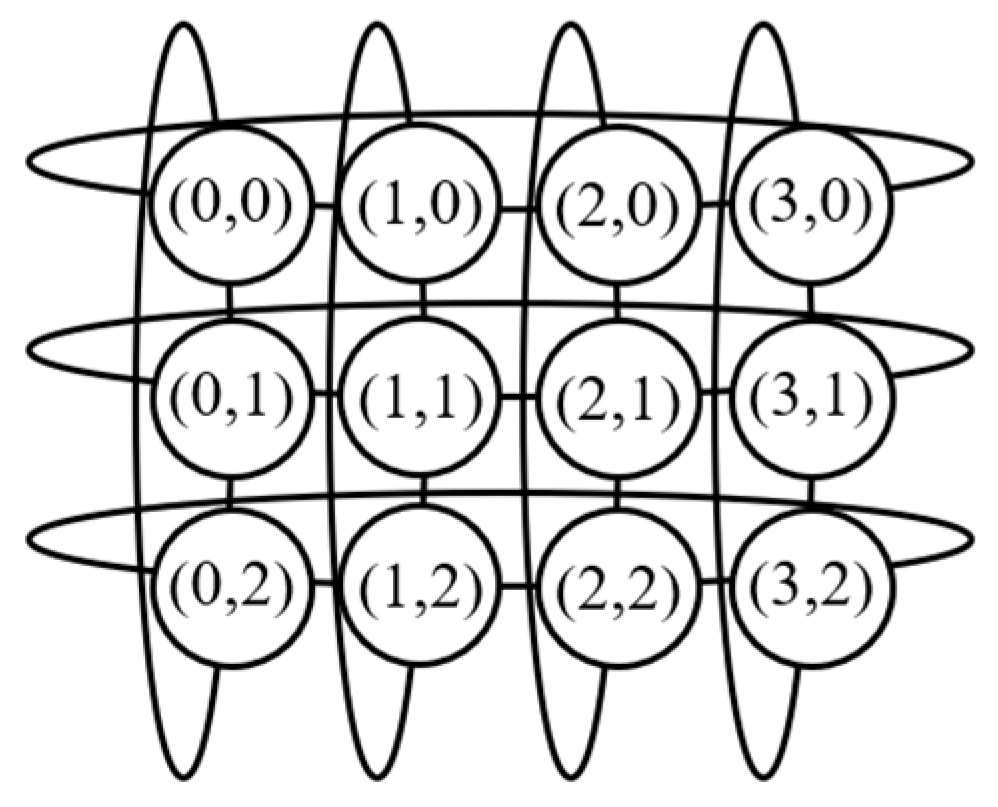
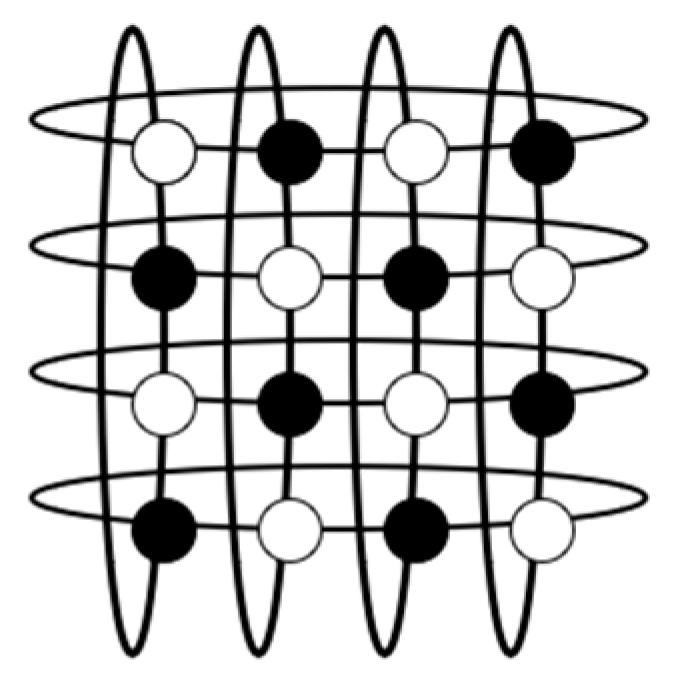
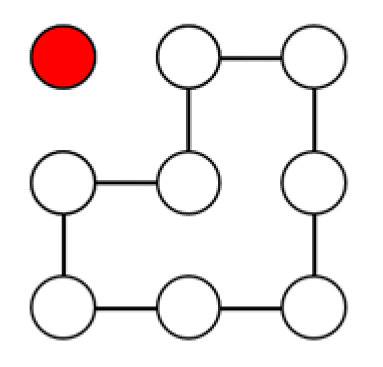


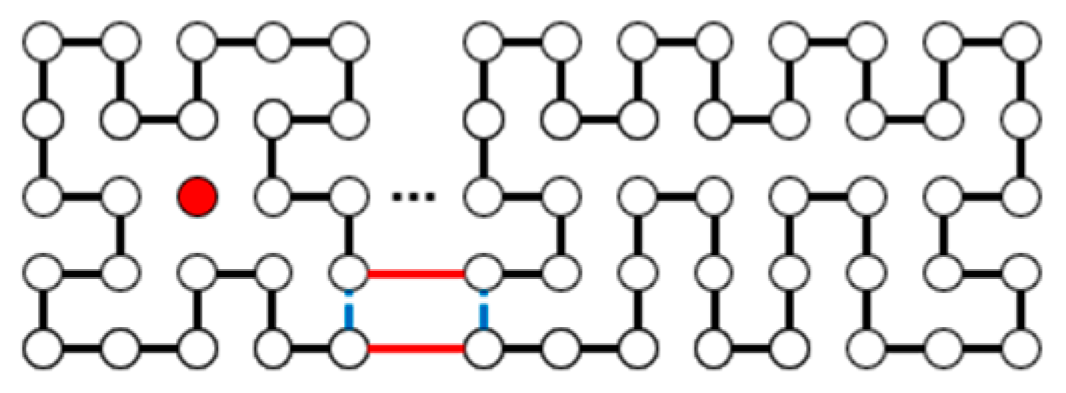
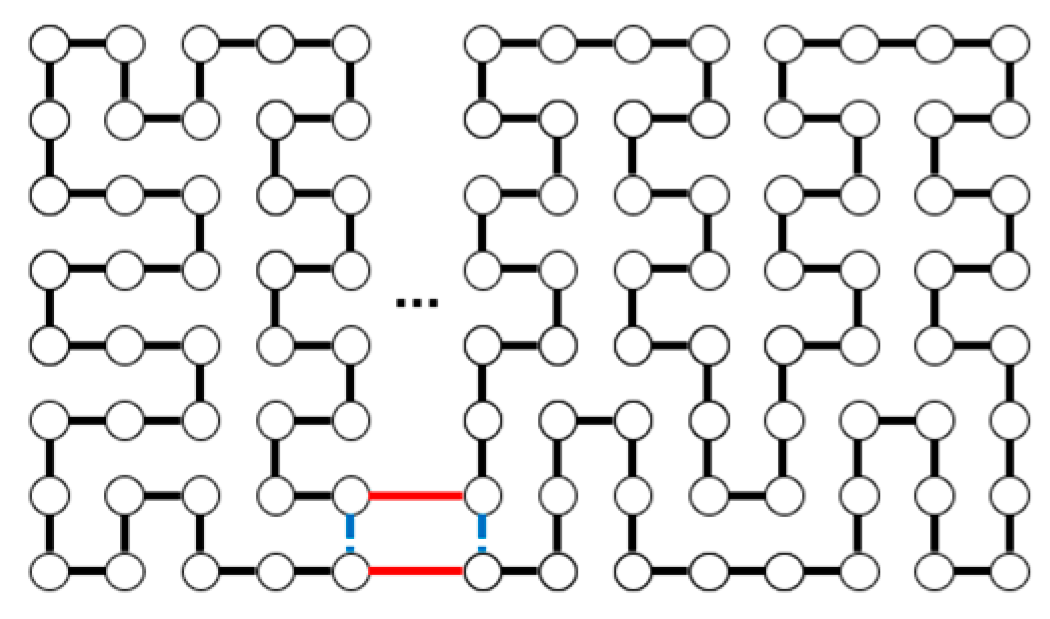
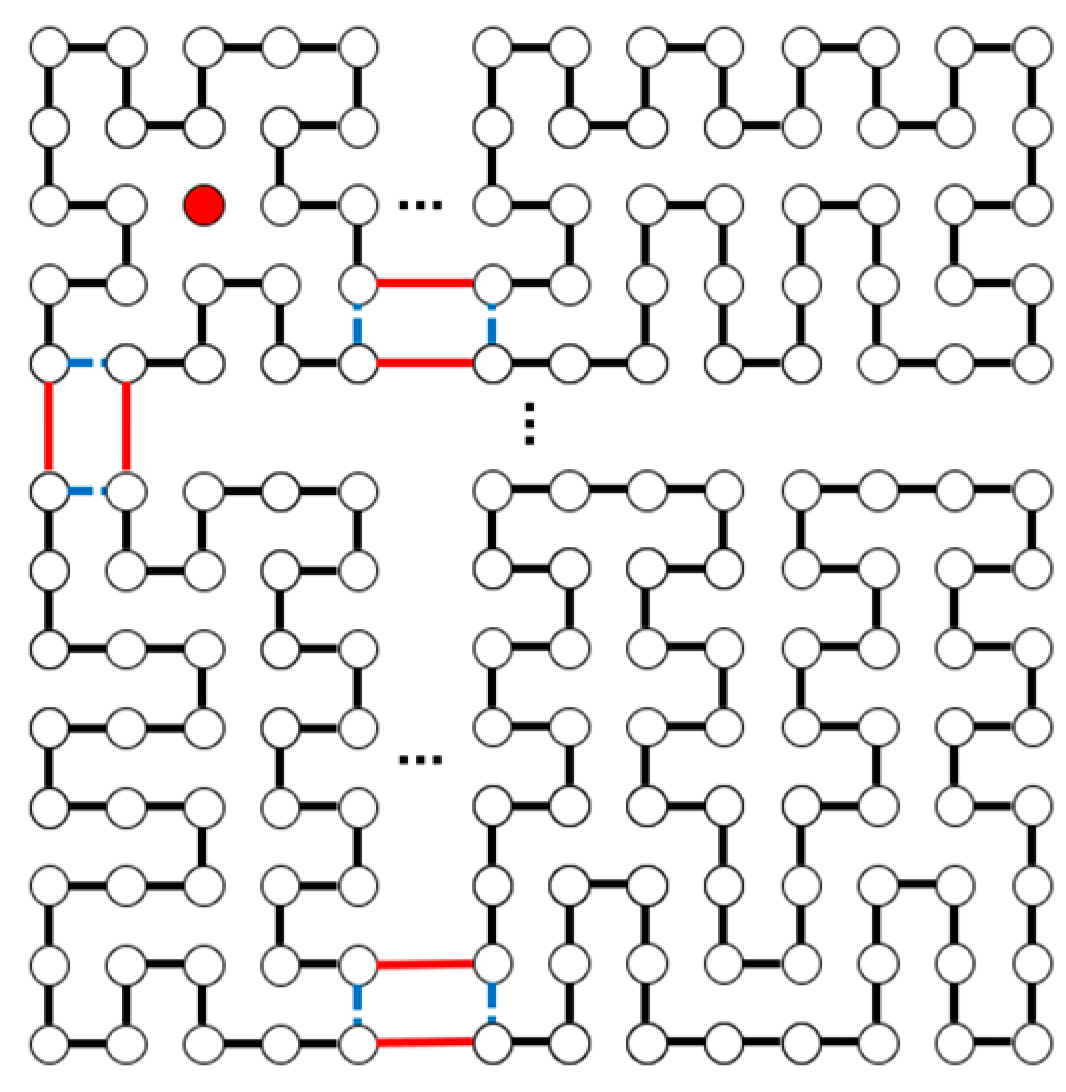
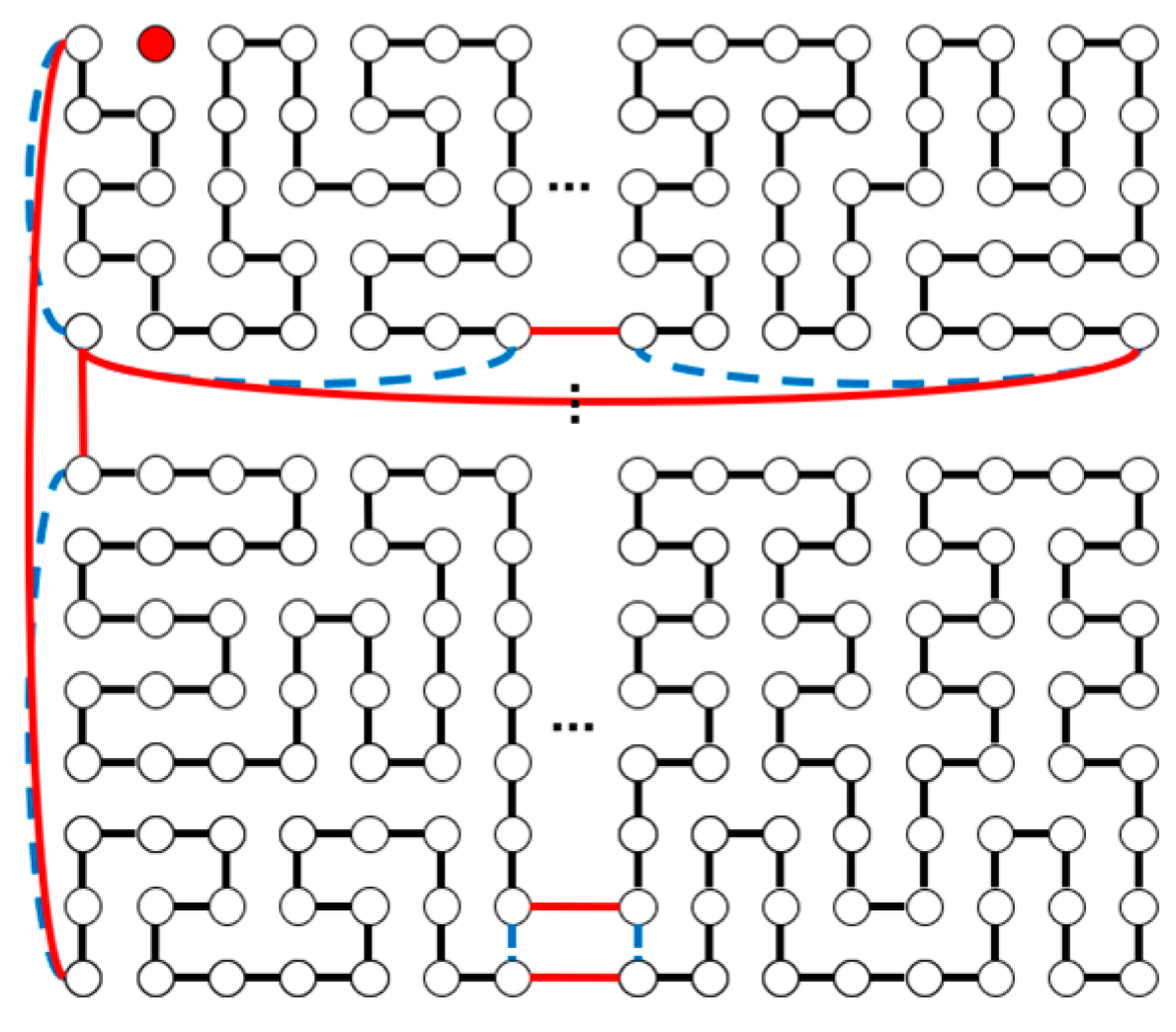
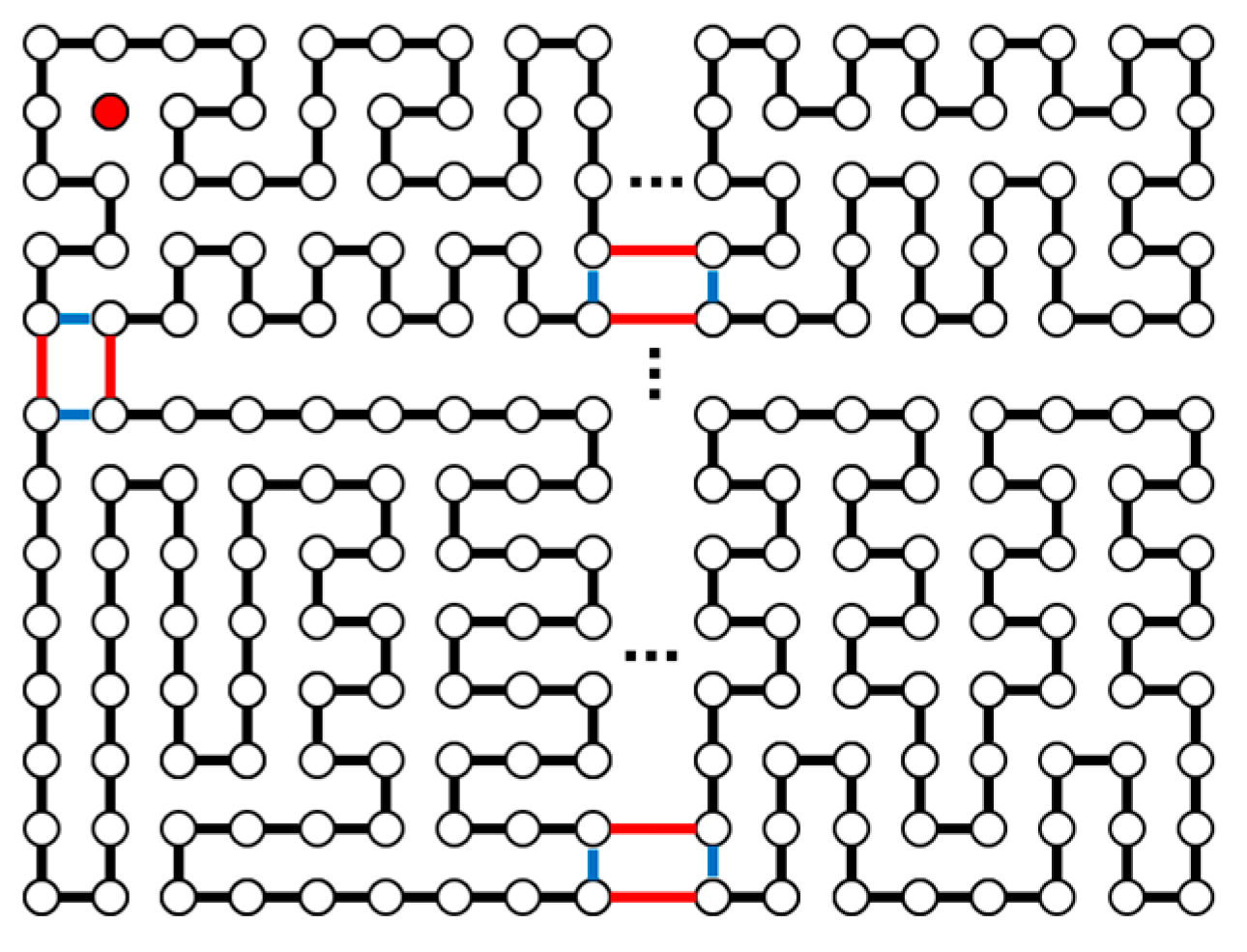
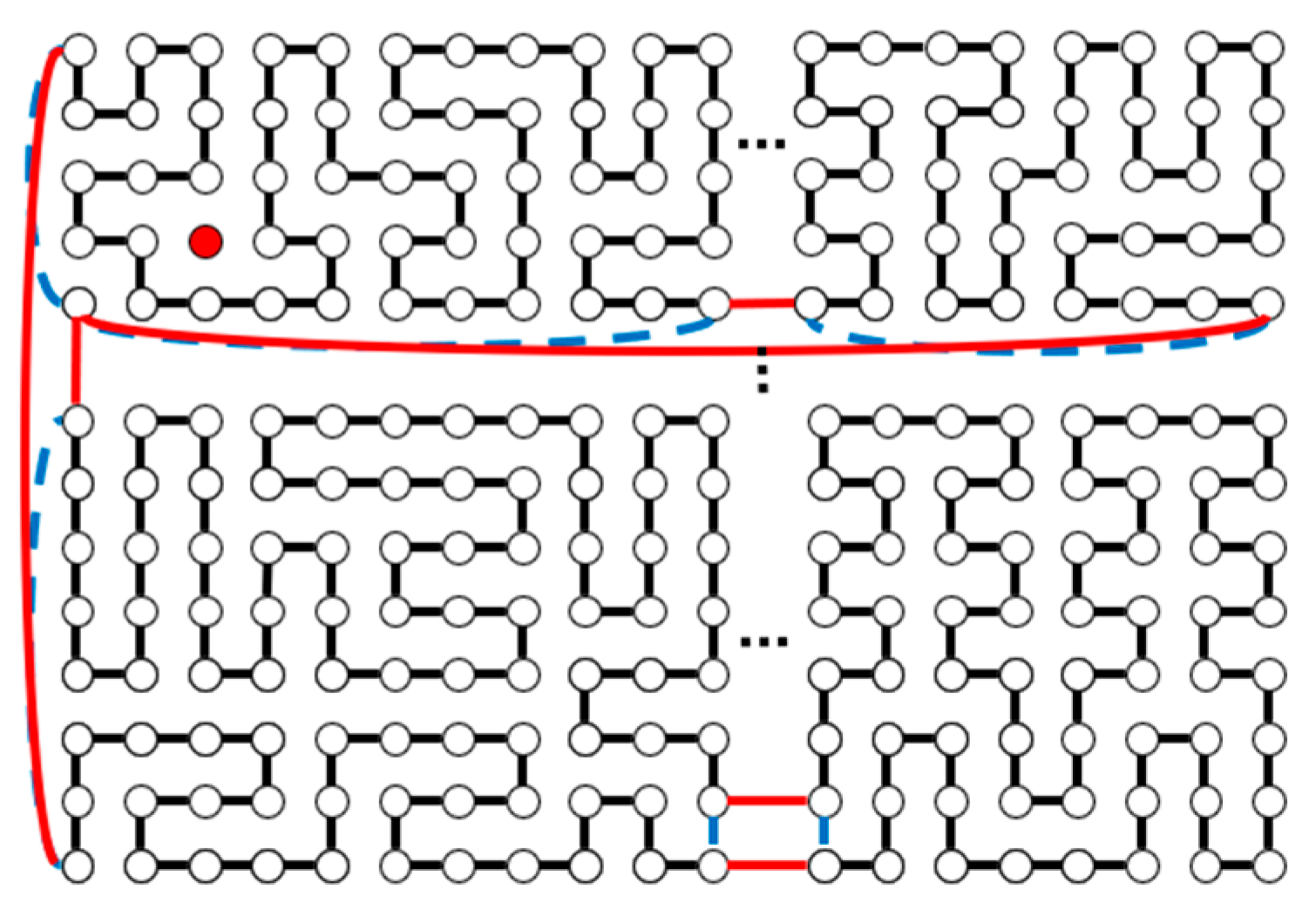
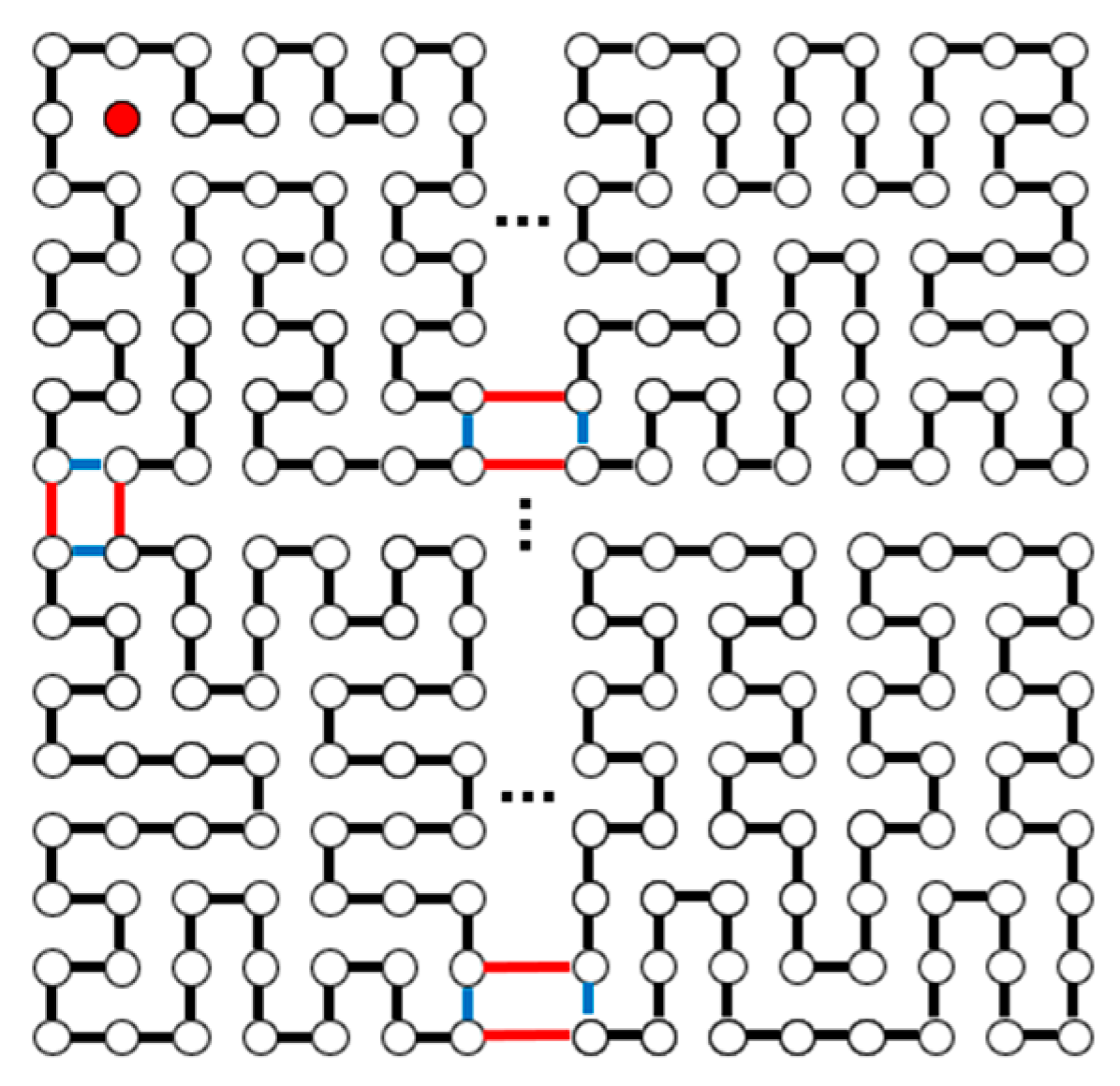
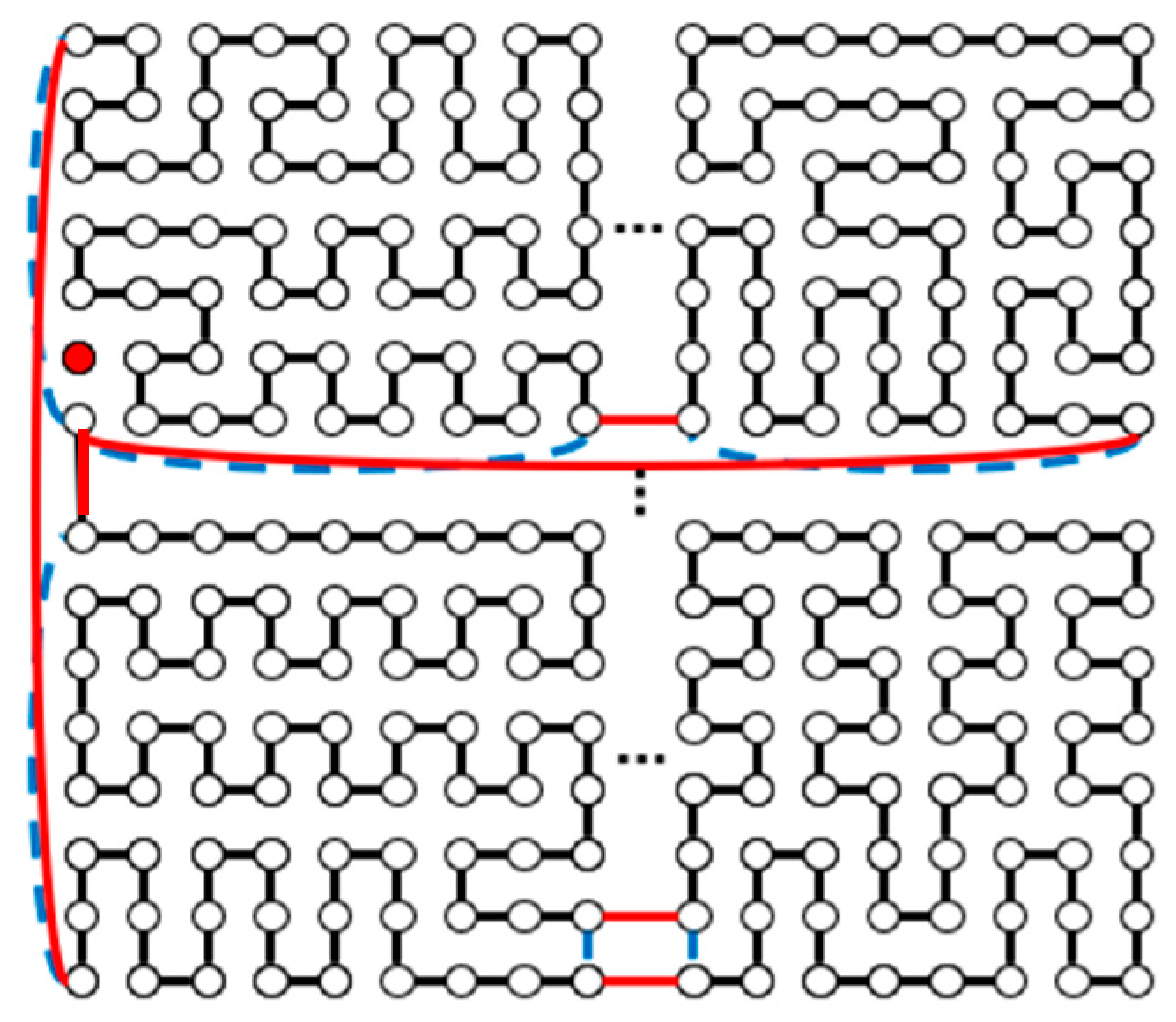
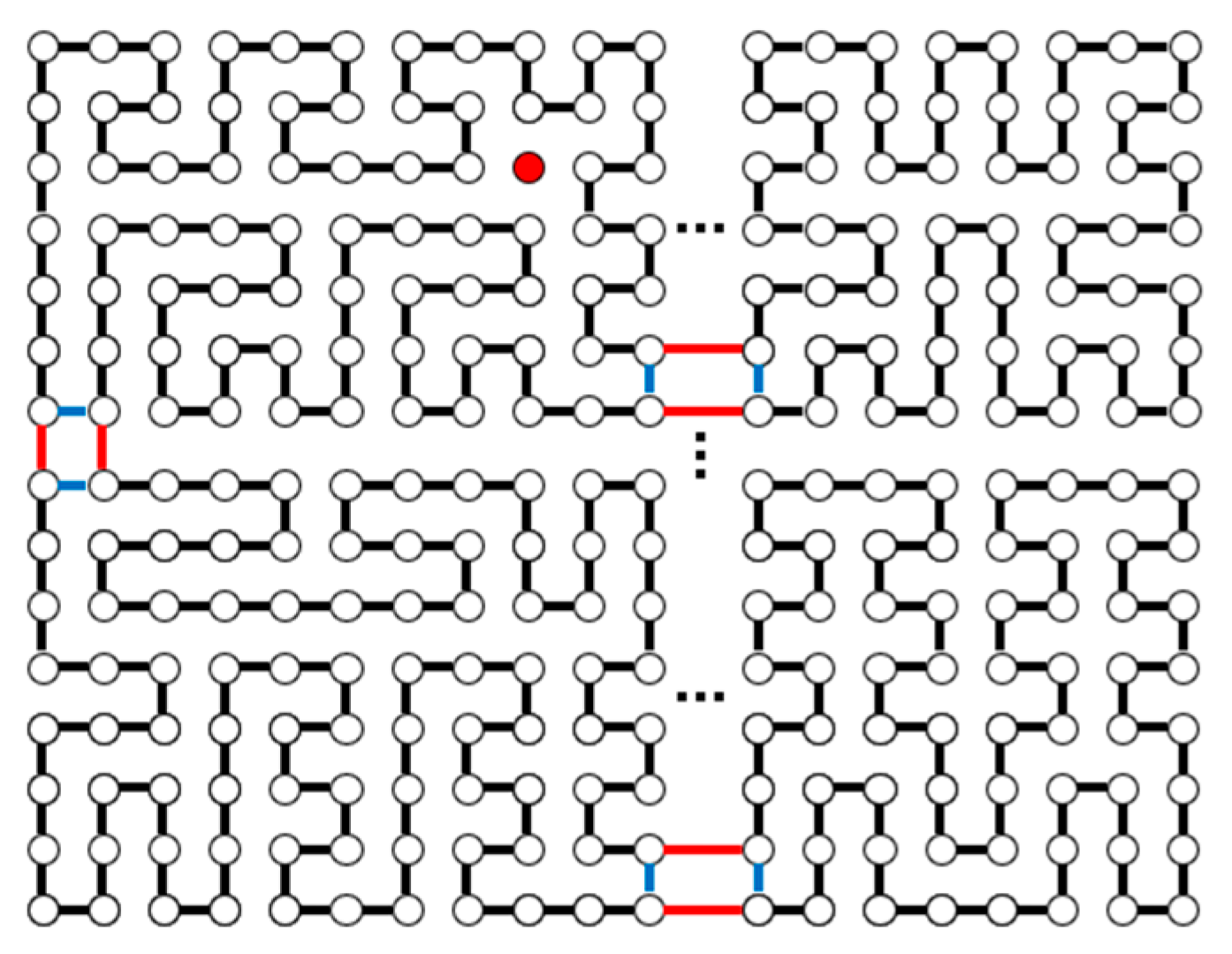
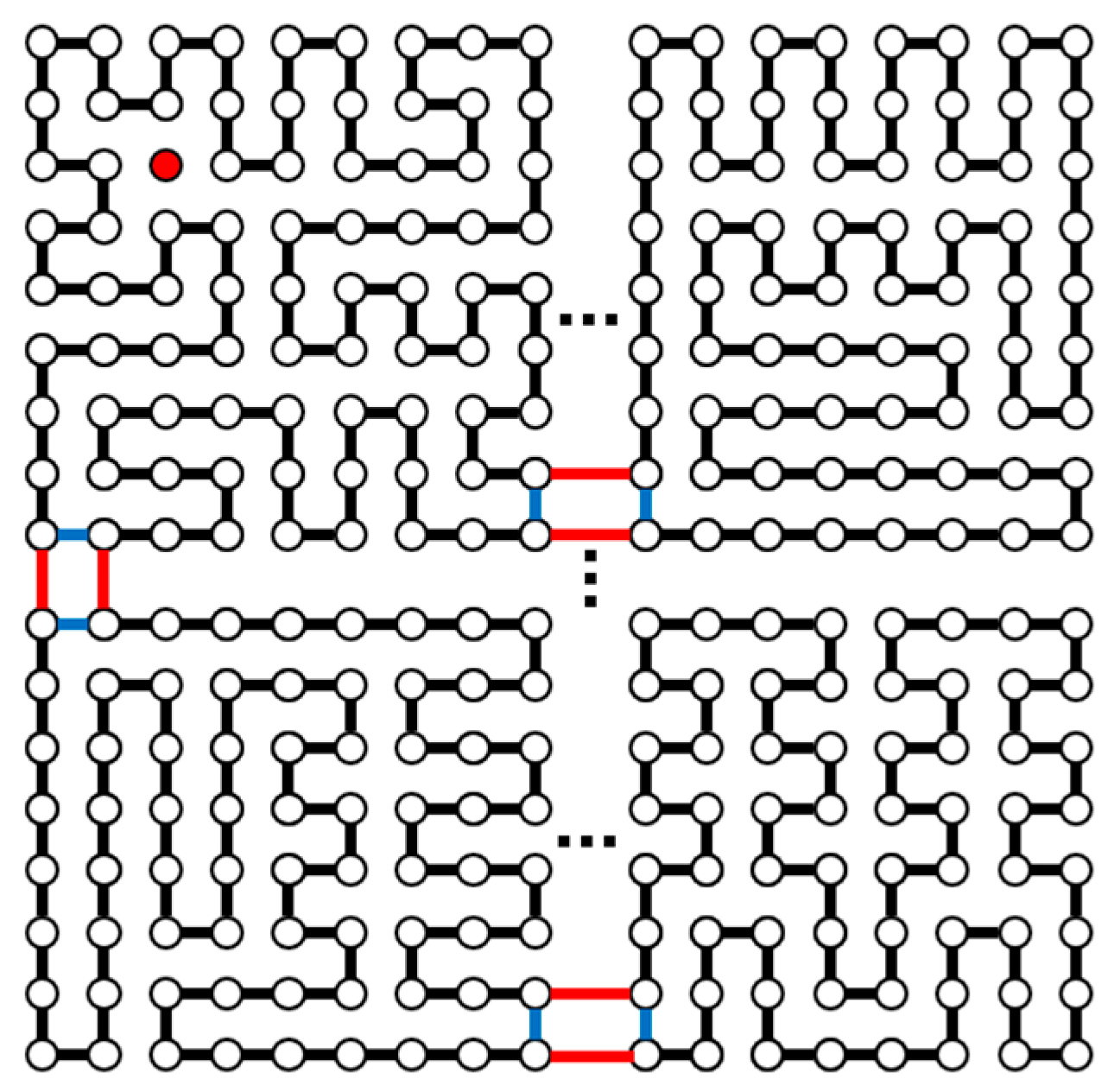
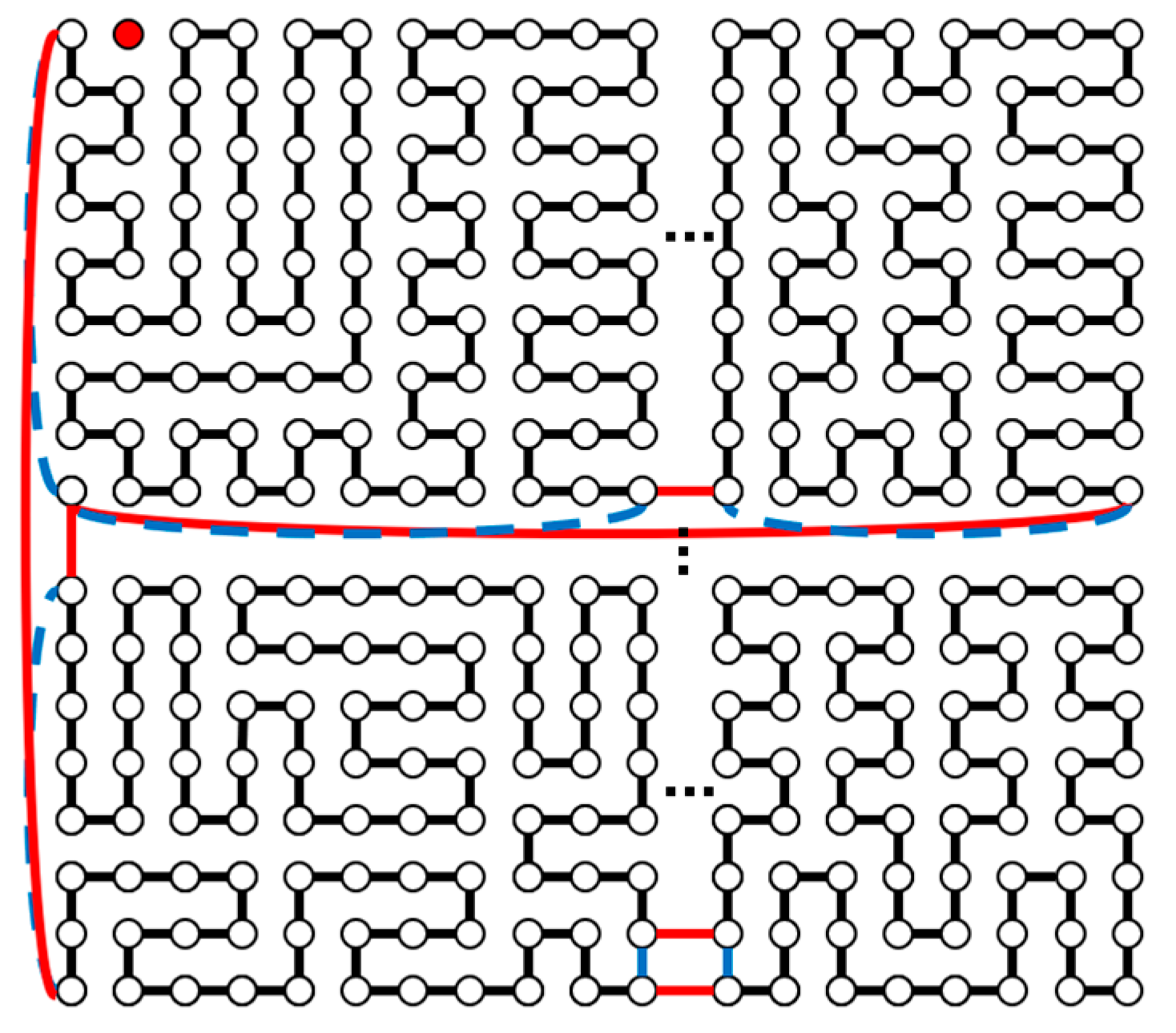
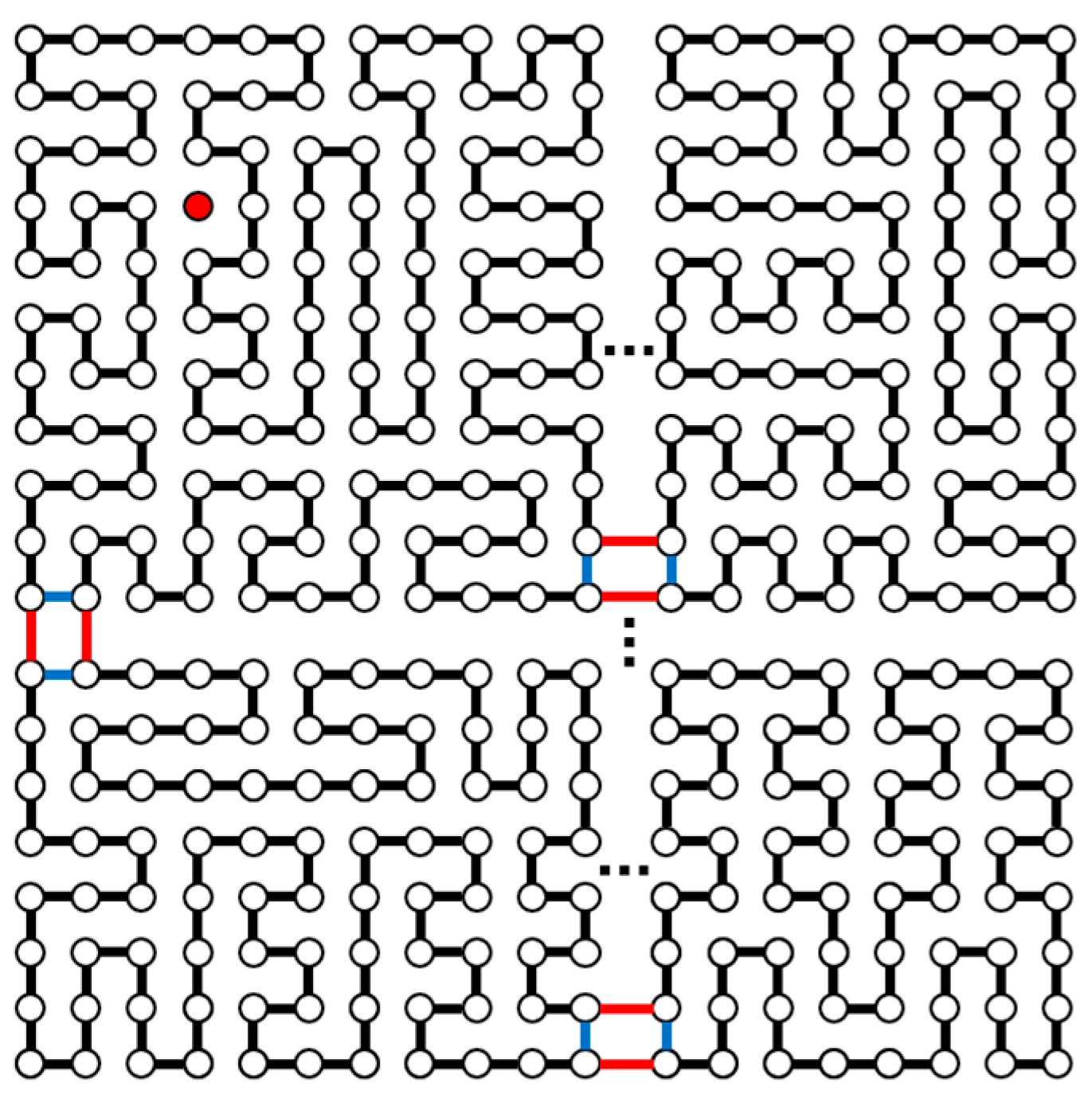


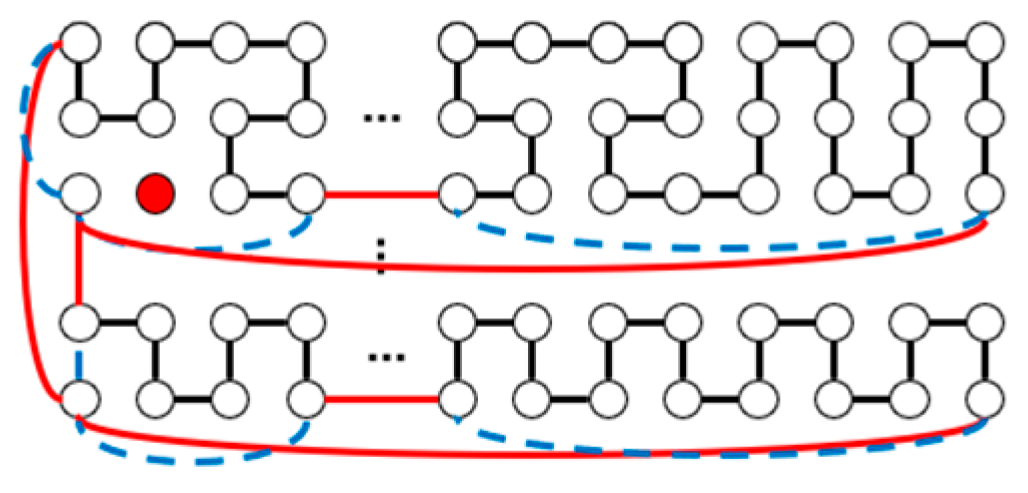
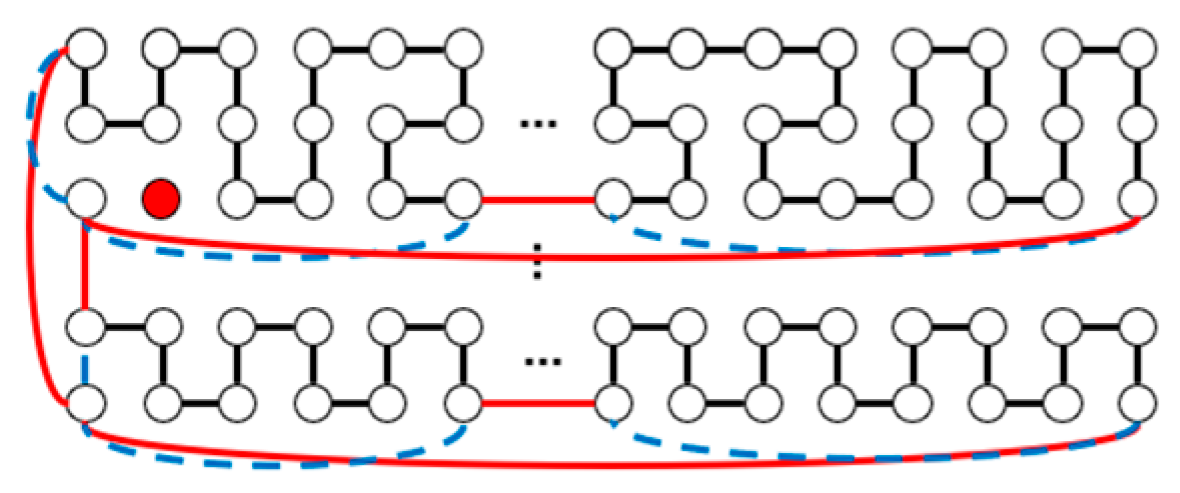

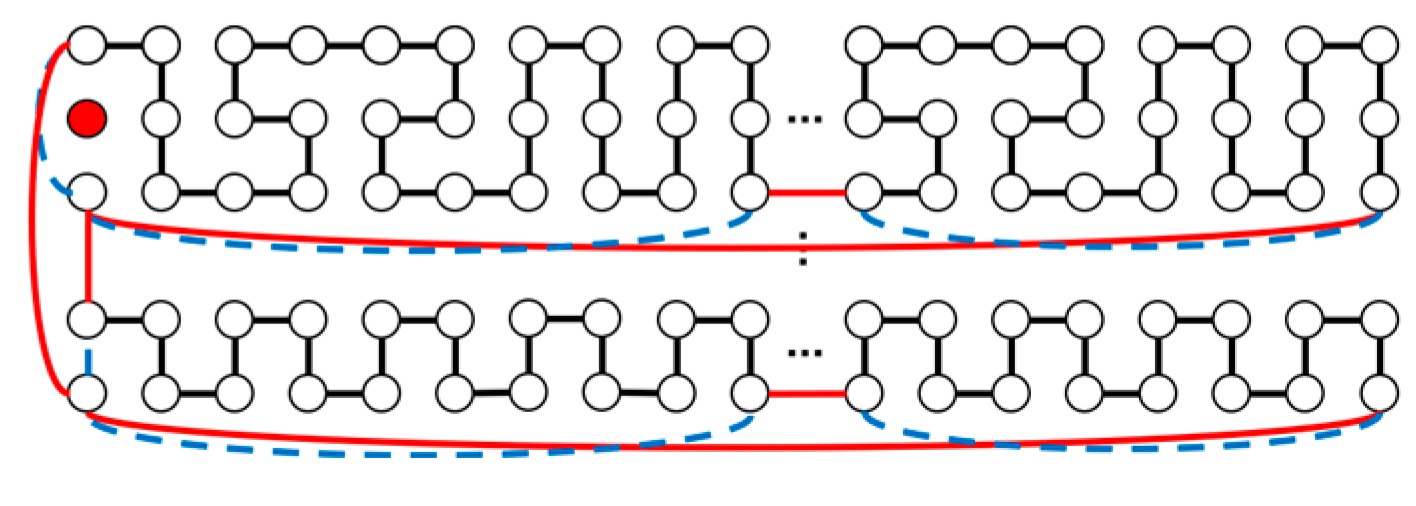
| m | m, n Are Odd | |||||
|---|---|---|---|---|---|---|
| n | 3 | 5 + 8p | 7 + 8p | 9 + 8p | 11+ 8p | |
| 3 | Thm. 2 (a) | Thm. 2 (b) | Cor. 1 | Thm. 2 (c) | Cor. 1 | |
| 5 + 8q | Thm. 2 (b) | Thm. 3 (a) | Thm. 3 (b) | Thm. 3 (c) | Thm. 3 (d) | |
| 7 + 8q | Cor. 1 | Thm. 3 (b) | Thm. 3 (e) | Thm. 3 (f) | Thm. 3 (g) | |
| 9 + 8q | Thm. 2 (c) | Thm. 3 (c) | Thm. 3 (f) | Thm. 3 (h) | Thm. 3 (i) | |
| 11 + 8q | Cor. 1 | Thm. 3 (d) | Thm. 3 (g) | Thm. 3 (i) | Thm. 3 (j) | |
| m | m Is Even and n Is Odd | ||||
|---|---|---|---|---|---|
| n | 4 + 8p | 6 + 8p | 8 + 8p | 10 + 8p | |
| 3 + 2q | Thm. 4 (a) | Thm. 4 (b) | Thm. 4 (c) | Thm. 4 (d) | |
| Reference | Multiprocessor Systems | Problems |
|---|---|---|
| [5] | Toroidal mesh graph (Tm,n) | two-fault H |
| [16] | Toroidal mesh graph (Tm,n) | DBH |
| [18] | Toroidal mesh graph (Tm,n) | DBP |
| [19] | Toroidal mesh graph (Tm,n) | WDBH |
| [20] | Toroidal mesh graph (Tm,n) | WDBP |
| [21] | 3-dimensional toroidal mesh graph (Tm,n,r) | DBH |
| This paper | Toroidal mesh graph (Tm,n) | one-fault DBH and DBP |
Disclaimer/Publisher’s Note: The statements, opinions and data contained in all publications are solely those of the individual author(s) and contributor(s) and not of MDPI and/or the editor(s). MDPI and/or the editor(s) disclaim responsibility for any injury to people or property resulting from any ideas, methods, instructions or products referred to in the content. |
© 2025 by the authors. Licensee MDPI, Basel, Switzerland. This article is an open access article distributed under the terms and conditions of the Creative Commons Attribution (CC BY) license (https://creativecommons.org/licenses/by/4.0/).
Share and Cite
Juan, J.S.-T.; Ciou, H.-C.; Lin, M.-J. The One-Fault Dimension-Balanced Hamiltonian Problem in Toroidal Mesh Graphs. Symmetry 2025, 17, 93. https://doi.org/10.3390/sym17010093
Juan JS-T, Ciou H-C, Lin M-J. The One-Fault Dimension-Balanced Hamiltonian Problem in Toroidal Mesh Graphs. Symmetry. 2025; 17(1):93. https://doi.org/10.3390/sym17010093
Chicago/Turabian StyleJuan, Justie Su-Tzu, Hao-Cheng Ciou, and Meng-Jyun Lin. 2025. "The One-Fault Dimension-Balanced Hamiltonian Problem in Toroidal Mesh Graphs" Symmetry 17, no. 1: 93. https://doi.org/10.3390/sym17010093
APA StyleJuan, J. S.-T., Ciou, H.-C., & Lin, M.-J. (2025). The One-Fault Dimension-Balanced Hamiltonian Problem in Toroidal Mesh Graphs. Symmetry, 17(1), 93. https://doi.org/10.3390/sym17010093







